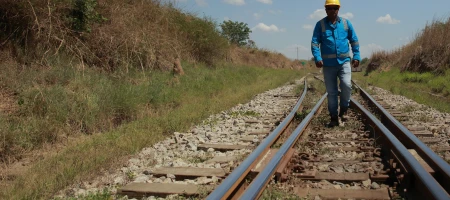
Towards a just energy transition - Experiences from South Africa
Two fundamental elements stand out in South Africa's energy transition: the interest of the private sector and industrialized countries in South Africa's high viability to produce green hydrogen, and the social dialogue in which trade unions have played an important role. Both elements generate key challenges for South Africa's just transition, which has been promoted in cooperation with the European Union and the United States.
South African experience is an example for other energy transition processes around the world. The Colombian government has recently invested in the development of green hydrogen and spaces for social dialogue have been created by trade unions, initiated by the Workers' Collective for Just Transition initiative with the support of CNV Internationaal.
South Africa and coal mining in the most unequal country in the world
According to the World Bank Gini index, , South Africa is the most unequal country in the world. With a population of 59 million people, it is the world’s twelfth largest CO2 emitter. Energy poverty is one of the main problems magnifying inequality in the country according to the South African Federation of Trade Unions (SAFTU) in Energy and Equity (2020), although electricity production is the main cause of carbon emissions in South Africa.
Business conglomerates
According to the World Bank Gini index, , South Africa is the most unequal country in the world. With a population of 59 million people, it is the world’s twelfth largest CO2 emitter. Energy poverty is one of the main problems magnifying inequality in the country according to the South African Federation of Trade Unions (SAFTU) in Energy and Equity (2020), although electricity production is the main cause of carbon emissions in South Africa.
Moving towards energy justice in South Africa
Against this backdrop (which also highlights the climate emergency and the rights' crisis that urgently needs to be addressed) South Africa has been moving towards the adoption of a just energy transition. Two fundamental elements stand out in this transition experience:
1. The support of European countries as well as the United States, stemming from their interest in South African potential to produce clean energy; and
2. The role of trade unions in the energy policy discussion on just transition.
COP26 - Green hydrogen and sustainable technologie
During the 26th Conference of the Parties to the Framework Convention on Climate Change (COP26), the Just Energy Transition Partnership (JETP) was created. The European Union, the United States and the United Kingdom committed to financially support the just energy transition in South Africa.
The private sector and the mobilisation of industrialised countries to promote South Africa's just energy transition is also motivated by the interest in energy production through green hydrogen.
COP26 - Green hydrogen and sustainable technologies
During the 26th Conference of the Parties to the Framework Convention on Climate Change (COP26), the Just Energy Transition Partnership (JETP) was created. The European Union, the United States and the United Kingdom committed to financially support the just energy transition in South Africa.
The private sector and the mobilisation of industrialised countries to promote South Africa's just energy transition is also motivated by the interest in energy production through green hydrogen.
International cooperation as a key element
With the aim of reducing coal in the African country's energy matrix, industrialised nations will provide 8.5 billion dollars to stimulate clean energy production from green hydrogen and to introduce technological developments such as electric vehicles. This support aims to eliminate up to 1.5 million gigatonnes of CO2 in twenty years.
During COP26, the European Union and the United States vowed to support affected workers and vulnerable communities, especially coal miners, women, and the youth, during the transformation of the South African economy. Theirs statement follows the pact by industrialised countries during the Paris Agreement to shift $100 billion a year to developing countries between 2020 and 2025.
How is it going to work?
The bulk of this economic incentive will be delivered in the form of loans, grants and investments to strengthen the new electricity industry in South Africa. In addition, the commitment not only involves governments of industrialised countries, but also the private sector and the World Bank.
South Africa has 75% of the world's platinum reserves, which is an important mineral to produce and store green hydrogen. Therefore, South Africa's viability of changing its electricity matrix towards a cleaner one lies in the wealth of this material.
Trade union mobilisation and its achievements for a just transition
Social dialogue has been key to a just transition. Positioning it in the change of South Africa's energy matrix has been an achievement of South African trade union movements. Thanks to trade union action, government plans for nuclear power and the investment of pension funds for renewable energy - which could have had negative consequences for the most vulnerable populations - have been put to a stop.
Hearing workers' demands
The Congress of South African Trade Unions (COSATU) has helped give voice to workers' demands for South Africa's energy transition in the National Economic Development and Labour Council (NEDLAC), an institution that facilitates social dialogue. COSATU's struggle in the energy policy context aims to support carbon reduction in the South African economy as long as the employment crisis and the ecological crisis are addressed.
COSATU and NEDLAC advocate for a just transition that
- is capable of reducing inequality in South Africa;
- protects workers' wages and social benefits; and
- redresses the environmental issues left behind by the coal industry.
One Million Jobs for Climate
COSATU, together with the National Council of Trade Unions (NACTU) and other organisations and social movements, launched the "One Million Jobs for Climate" campaign to place pressure on the government to implement just transition strategies. The aim is also to be able to move towards renewable energies based on energy as a public property, in order to close the energy gap in the different sectors of South African society. It also proposes the relocation of factories required to produce the essential materials for clean energy to South Africa to boost job creation.
Dimensions considered for a just transition
The just energy transition promoted by social organisations and movements in South Africa is divided into three dimensions:
1) Procedural justice, which seeks to include communities that are affected during the transition.
2) Distributive justice, which seeks to generate decent jobs for mine employees and communities who lost their jobs.
3) Restorative justice, which involves breaking the legacy settlement of colonisation and apartheid. With this, the transition of the energy matrix towards clean energy would be accompanied by measures necessary to mitigate inequality in South Africa.
Challenges for South Africa's energy transition
One of the biggest challenges towards a just energy transition including technological development and environmentally-friendly industries, will be training workers to meet the demands of these new technologies. Therefore, it will be key in the coming years to implement training, retraining and coaching plans for the workforce accustomed to the coal industry. According to a study published by Cobenefits, it is estimated that up to 79,000 clean energy jobs could be created by 2030 in South Africa's coal-producing province of Mpumalanga.
Green hydrogen
Platinum to produce green hydrogen could also mean an increase in platinum mining - new jobs. However, they must ensure that along with mining growth, there are fair conditions for workers.
COP26
The COP26 and the support South Africa received to initiate its just energy transition shows the importance of building partnerships with the private sector. The commitment must be to promote spaces for consultation with trade unions and social movements, in which plans can be defined for a fairer energy economy that is not part of the monopolistic logic promulgated in coal mining, that has generated inequality in the country.
From South Africa to Colombia
South Africa's case is an example of how some countries benefit from the necessary support for a just energy transition from developed countries and the private sector. This is due to the country’s resources required to produce clean energy. The Colombian case is similar because it is also a middle-income and post-conflict country. Moreover, its natural resources and geographical location are beneficial to the development of this economy. Furthermore, as a coal-producing country, Colombia is key to Europe's energy security in the context of the conflict between Russia and Ukraine.
New energy sources
In addition to the potential of wind energy in Cesar and La Guajira, the Colombian government has started financing projects for the development of green hydrogen for more than 6.5 billion (COP). This alternative would mainly be developed in La Guajira, so it is necessary to think about economic diversification that could also help further develop the economy of regions such as Cesar and Magdalena. Thus, Colombia's relations with northern countries and the attraction of the private sector for investment in renewable energies are opportunities for a just and structural transition in the country.
Including the voice of workers into the energy policy agenda
The energy transition in South Africa has demonstrated the importance of the synergy achieved by trade unions. They were able to include just transition into the energy policy agenda. It is essential that Colombian trade union movements also manage to articulate their demands and actions. This is what the Workers' Collective for a Just Transition is doing. It is made up of five Colombian mining unions, and is joining hands with other social, political and environmental movements and organisations. Their aim is to strengthen the voice of the workers and to initiate a tripartite dialogue towards a just energy transition, in which trade unions, businesses and governments participate, as it happened in South Africa.
Learning from successes and failures
Focusing on the development of South Africa's just energy transition is an opportunity for Colombia to learn from the successes (which it must take into account and implement) and the failures (to avoid at all costs), in order to carry out a successful just energy transition. One that is capable of reducing the inequality that strongly affects as well as South Africa as Colombia.
